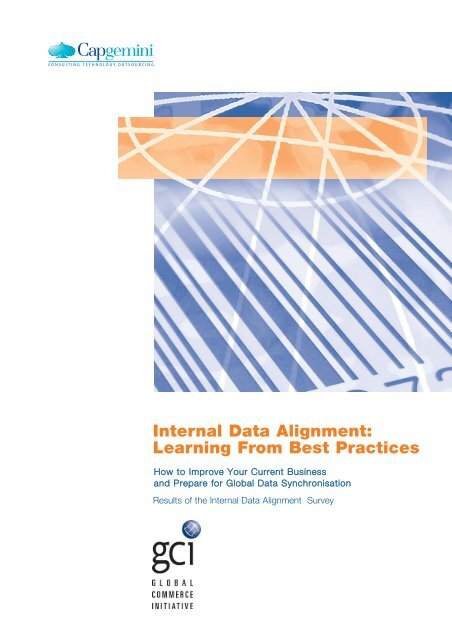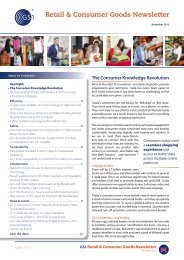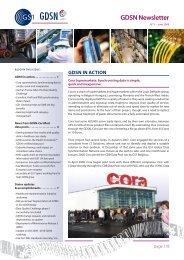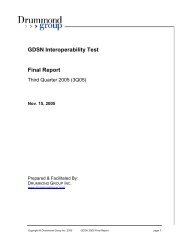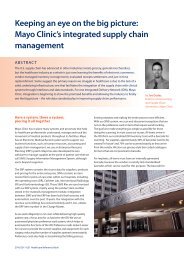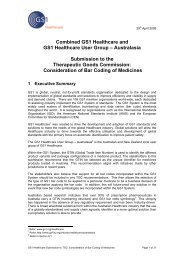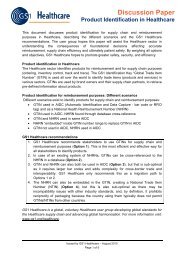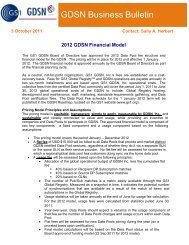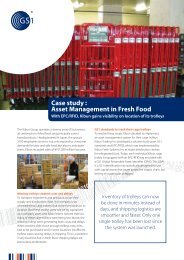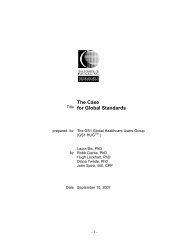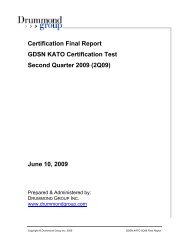Internal Data Alignment: Learning From Best Practices - GS1
Internal Data Alignment: Learning From Best Practices - GS1
Internal Data Alignment: Learning From Best Practices - GS1
Create successful ePaper yourself
Turn your PDF publications into a flip-book with our unique Google optimized e-Paper software.
<strong>Internal</strong> <strong>Data</strong> <strong>Alignment</strong>:<br />
<strong>Learning</strong> <strong>From</strong> <strong>Best</strong> <strong>Practices</strong><br />
How to Improve Your Current Business<br />
and Prepare for Global <strong>Data</strong> Synchronisation<br />
Results of the <strong>Internal</strong> <strong>Data</strong> <strong>Alignment</strong> Survey
ACKNOWLEDGEMENTS<br />
Capgemini was able to conduct this study thanks to the full support and<br />
leadership of the Global Commerce Initiative (GCI). In particular, we would<br />
like to thank Nigel Bagley (Unilever), Jeremy Hollows (Carrefour) and<br />
Natascha Pottier (GCI Project Management Office) for their efforts.<br />
We also extend our thanks to all the retailers and manufacturers that provided<br />
their valuable input for this study.<br />
Special thanks also goes to the Capgemini team, led by Kees Jacobs,<br />
which included Frank Smeets, Rob van den Elzen, Ard Jan Vethman, Ron<br />
Johnson, Scott Merrill and Stephen Alvey.<br />
May 2004 © Copyright 2004, Capgemini/Global Commerce Initiative
INTERNAL DATA ALIGNMENT:<br />
LEARNING FROM BEST PRACTICES<br />
How to Improve Your Current Business and Prepare<br />
for Global <strong>Data</strong> Synchronisation<br />
CONTENTS<br />
Introduction: The Critical Role of <strong>Internal</strong> <strong>Data</strong> <strong>Alignment</strong> in the Supply Chain 4<br />
Executive Summary 5<br />
General Background and Scope of <strong>Internal</strong> <strong>Data</strong> <strong>Alignment</strong> Activities 8<br />
Companies Provide Dedicated Focus on <strong>Data</strong> <strong>Alignment</strong> 8<br />
<strong>Internal</strong> and External Triggers Drive <strong>Data</strong> <strong>Alignment</strong> Projects 9<br />
Funding Comes <strong>From</strong> Corporate and Operating Companies 12<br />
10 High-Level Sponsorship Is Critical 12<br />
Making the Business Case for <strong>Data</strong> <strong>Alignment</strong> 13<br />
Synergy Among Operating Companies Is the Preferred Approach 15<br />
15 Accuracy Objectives Defined 16<br />
“Getting <strong>Data</strong> Clean” and “Keeping <strong>Data</strong> Clean” 17<br />
Initial <strong>Data</strong> Cleansing: “Get Your <strong>Data</strong> Clean” 18<br />
Activities: Mapping, Checking and Aligning 18<br />
Dedicated Resources Help Avoid Bottlenecks 19<br />
Involved Departments: Ownership <strong>From</strong> the Business Side 20<br />
<strong>Data</strong> Cleansing Takes Time 21<br />
Structural <strong>Internal</strong> <strong>Data</strong> <strong>Alignment</strong>: “Keep Your <strong>Data</strong> Clean” 22<br />
Activities and Timing: <strong>Data</strong> <strong>Alignment</strong> Is a Work in Progress 22<br />
Impact on Processes Will Occur Across the Entire Business 23<br />
Impact on the Organisation: Centralisation Is Key 25<br />
Impact on Trading Partner Collaboration 27<br />
Impact on IT Platform 28<br />
Architecture 28<br />
Product Information Management (PIM) 29<br />
Workflow 30<br />
Corporate vs. Operating Company Solutions 31<br />
Impact on <strong>Data</strong> Standards 32<br />
<strong>Best</strong> <strong>Practices</strong> in Action: <strong>Internal</strong> <strong>Data</strong> <strong>Alignment</strong> Case Studies 33<br />
Manufacturer Case Example: SCA Hygiene 33<br />
Retailer Case Example: Delhaize 34<br />
Conclusion: How to Make <strong>Internal</strong> <strong>Data</strong> <strong>Alignment</strong> a Reality 35
INTRODUCTION<br />
The Critical Role of <strong>Internal</strong> <strong>Data</strong> <strong>Alignment</strong> in the Supply Chain<br />
Accurate and consistent item data is the cornerstone<br />
for an efficient, collaborative supply chain. It affects<br />
every aspect of the business (including sales,<br />
buying/merchandising, supply chain and finance). If<br />
the data quality is poor, initiatives like Global <strong>Data</strong><br />
Synchronisation (GDS) and Electronic Product<br />
Code/Radio Frequency Identification (EPC/RFID) will<br />
not fully deliver the promised benefits. Many retailers<br />
and manufacturers today are faced with major issues<br />
regarding their internal data integrity. Apart from the<br />
fact that this creates business inefficiencies, the big<br />
danger is that all these collaborative initiatives will only<br />
lead to an acceleration of the problems resulting from<br />
poor data quality.<br />
About the <strong>Data</strong> <strong>Alignment</strong> Research<br />
To examine the state of data alignment in the retail and consumer<br />
products industry and identify best practices, the Global<br />
Commerce Initiative (GCI) and Capgemini surveyed a worldwide<br />
audience of retailers and manufacturers. The survey contained<br />
30 questions inquiring about the strategies, practices and learnings<br />
of these companies regarding <strong>Internal</strong> <strong>Data</strong> <strong>Alignment</strong>.<br />
The questionnaire resulted in strong response, both qualitative<br />
as well as quantitative. All of the participating companies are<br />
dealing with <strong>Internal</strong> <strong>Data</strong> <strong>Alignment</strong> activities. In a number of<br />
cases Capgemini conducted subsequent interviews.<br />
In total 39 companies provided feedback: 17 retailers and 22<br />
manufacturers. These companies represent a balance of geographical<br />
coverage:<br />
• 34% of responding companies (primarily manufacturers)<br />
have a truly global spread<br />
• 40% of companies have their origin and predominant base<br />
in Europe<br />
• 20% of companies have their origin and predominant base<br />
in North America<br />
• 3% of companies are based in Asia Pacific<br />
• 3% of companies are based in South America<br />
Responses were received from both corporate headquarters as<br />
well as local operating companies.<br />
The good news is that many retailers and manufacturers<br />
are addressing this issue. The learnings from these<br />
companies will be valuable for other retailers and<br />
manufacturers that are struggling with this issue or<br />
have yet to address it.<br />
Capgemini has studied and analysed a number of best<br />
practices in the area of data alignment. On the following<br />
pages, we present the findings of this work and<br />
provide practical takeaways for retailers and manufacturers.<br />
Retailers that provided input included (amongst others)<br />
Ajinomoto, Big Food Group, Carrefour, Coop Italia, CVS,<br />
Delhaize/Food Lion, The Home Depot, Hudson's Bay, METRO<br />
Group, Royal Ahold, Tesco and Wegmans.<br />
Participating manufacturers included (amongst others) Allied<br />
Domecq, Georgia-Pacific, Gillette, Groupe Danone, Heineken,<br />
Heinz, Johnson & Johnson, Kraft Foods, Masterfoods, Nestlé,<br />
Procter & Gamble, Reckitt Benckiser, Sara Lee, SCA Hygiene<br />
and Unilever.<br />
All responses were analysed anonymously.<br />
This <strong>Internal</strong> <strong>Data</strong> <strong>Alignment</strong> study is a follow-up to “The Case<br />
for Global Standards: Creating the Business Case for Global<br />
<strong>Data</strong> Synchronisation in Your Company” (October 2002) and<br />
“The Implementation Roadmap for Retailers and Manufacturers”<br />
(May 2003), which were developed and published by the Global<br />
Commerce Initiative and Capgemini. The business case report<br />
provides the background and business rationale for adopting<br />
global standards and Global <strong>Data</strong> Synchronisation and addresses<br />
the implications of implementation. The roadmap provides an<br />
implementation framework of activities, milestones and critical<br />
success factors. <strong>Internal</strong> <strong>Data</strong> <strong>Alignment</strong> is an important enabler<br />
in this roadmap. This current report provides a more detailed<br />
focus on this subject. The business case and data alignment<br />
reports are available online at www.capgemini.com/GCIcase<br />
and www.gci-net.org.<br />
4
EXECUTIVE SUMMARY<br />
Accuracy and consistency of product data are lacking at<br />
both retailers and manufacturers. In fact, our research<br />
found that more than half of the items in company systems<br />
contain incorrect data (for example, wrong values<br />
and duplicate or obsolete entries). <strong>Internal</strong> <strong>Data</strong> <strong>Alignment</strong><br />
is about improving this situation, by having the<br />
product data across the various business systems consistent,<br />
complete, accurate and available in a timely<br />
manner.<br />
Three main factors have caused the current situation:<br />
• People: Ownership of data is unclear; business<br />
employees often do not take responsibility for it;<br />
and the people who do care about data quality<br />
don’t get rewarded for it.<br />
• Processes: Managing accurate and consistent<br />
product information has cross-functional impact<br />
(e.g., involving supply chain, buying/<br />
merchandising, sales/marketing), but there are no<br />
true cross-functional processes defined for this.<br />
Product information is mostly managed by means<br />
of fragmented processes.<br />
• Technology: Product information currently resides<br />
in various systems in different formats with<br />
different rules and standards, used by different<br />
parts of the organisation.<br />
This situation has a significant business impact on<br />
retailers and manufacturers. For example, it has caused<br />
a number of inefficiencies, like duplicative and manual<br />
re-entry of data. Considerable effort is needed to manually<br />
“clean” and align the data from various sources.<br />
This also causes incorrect orders and invoices (and the<br />
subsequent corrective actions) and long lead times for<br />
data recording. At the end, it has a negative impact on<br />
consumer satisfaction as well, due to problems such as<br />
out-of-stocks that directly stem from inaccurate data.<br />
In addition, this prevents adequate collaboration<br />
between retailers and manufacturers. Without <strong>Internal</strong><br />
<strong>Data</strong> <strong>Alignment</strong>, for example, Global <strong>Data</strong><br />
Synchronisation (GDS) will definitely not improve<br />
business performance and will, in fact, magnify the<br />
negative impact of poor quality data. What’s more, collaborative<br />
initiatives such as those included in Efficient<br />
Consumer Response (ECR) and Collaborative Planning,<br />
Forecasting and Replenishment (CPFR) will not be economically<br />
deployable on a wide scale without the consistently<br />
accurate and available information that will<br />
result from an <strong>Internal</strong> <strong>Data</strong> <strong>Alignment</strong> program.<br />
Finally, the use of new enabling technology such as<br />
EPC-enabled RFID tags, which will provide previously<br />
unimagined visibility across the supply chain, simply<br />
will not bring their promised benefits unless they are<br />
built on a foundation of quality information.<br />
This is not just a manufacturer issue. Retailers and<br />
manufacturers alike are impacted by this industry<br />
problem. This is not just a manufacturer issue. Retailers<br />
depend on the accuracy of the data that is provided by<br />
their manufacturers. But in turn, these manufacturers<br />
depend on the retailer’s ability to embed this data consistently<br />
in their systems.<br />
A fair number of retailers and manufacturers have identified<br />
the need to address their <strong>Internal</strong> <strong>Data</strong><br />
<strong>Alignment</strong>. Most of these companies are still working<br />
on this. Their experiences provided some interesting<br />
takeaways for companies that are about to embark on<br />
this journey.<br />
An important finding was that nearly all companies<br />
have been able to achieve executive commitment and<br />
proactive involvement from the business side of their<br />
operations. This is definitely not something only for IT<br />
and data management; business departments such as<br />
supply chain, buying/merchandising and sales/marketing<br />
need to take ownership of this issue.<br />
5
Most companies defined a dedicated project for<br />
<strong>Internal</strong> <strong>Data</strong> <strong>Alignment</strong> as opposed to embedding this<br />
in another project like ERP implementation. The message<br />
is clear: Have a dedicated project focus and make<br />
dedicated business resources available.<br />
The research also examined the triggers that have led<br />
retailers and manufacturers to assign dedicated projects.<br />
Although a combination of internal and external<br />
factors play a role in these decisions, it is clear that<br />
external business needs, such as GDS, are a crucial<br />
driver for internal alignment activities.<br />
A Two-Step Approach to <strong>Data</strong> <strong>Alignment</strong><br />
<strong>Internal</strong> <strong>Data</strong> <strong>Alignment</strong> is a two-step process. First, it<br />
is about “getting data clean,” as an initial, one-time<br />
activity to clean up the current inaccuracies. Secondly,<br />
it is about “keeping data clean” – ensuring that the root<br />
causes of data inaccuracies are addressed in a permanent<br />
manner. It is clear that the only way forward is to<br />
conduct both steps.<br />
The retailers and manufacturers working on <strong>Internal</strong><br />
<strong>Data</strong> <strong>Alignment</strong> strongly believe that this will bring<br />
them tangible benefits. It is recommended that companies<br />
build a business case before starting, and define<br />
and track concrete KPIs (key performance indicators).<br />
Getting data clean is about mapping, checking and<br />
aligning data, which is a manual, labour-intensive<br />
effort. This will take most companies between six and<br />
12 months to accomplish.<br />
Keeping data clean is about aligning processes, organisation,<br />
standards, IT solutions and trading partner collaboration.<br />
This will take most companies at least two<br />
years to develop, implement and, most importantly,<br />
institutionalise these changes.<br />
It is important to acknowledge that <strong>Internal</strong> <strong>Data</strong><br />
<strong>Alignment</strong> will impact nearly all business processes and<br />
the entire organisation. Adequate product information<br />
management processes, with clear roles and responsibilities,<br />
need to be defined. This issue is largely about<br />
people and their behaviour. Responsibility and ownership<br />
among business employees is critical. Performance<br />
measurements and reward structures need to be taken<br />
into account as well.<br />
Centralisation of data management activities is<br />
inevitable. Although basic responsibility for data quality<br />
lies with the business side, centralised coordination,<br />
guidance and support are essential to guarantee, control<br />
and maintain a consistent set of accurate data. The<br />
level of centralisation may be different per situation (for<br />
example, in some cases on a country level, and in other<br />
cases on a regional or even global level).<br />
Technology Plays a Key Role<br />
Of course, technology is a major enabler for <strong>Internal</strong><br />
<strong>Data</strong> <strong>Alignment</strong>. Nearly all companies participating in<br />
the study indicated that data alignment will have a<br />
major impact on their current IT landscape. The most<br />
important technology aspects are about Product<br />
Information Management (PIM) solutions as a “single<br />
source of truth” and workflow to support the item<br />
management processes.<br />
A majority of companies have seen the need to implement<br />
a separate PIM solution. These solutions act as a<br />
“spider in the web,” containing the accurate and consistent<br />
set of master data, to be fed and used by the<br />
various functional business applications. This central<br />
catalogue also acts as a gateway for external data synchronisation<br />
(GDS). These solutions are tightly coupled<br />
with workflow support that seamlessly connects all<br />
functional business owners, guiding them in their data<br />
responsibilities.<br />
6
The retailers and manufacturers participating in the<br />
research indicated that successful implementation of<br />
data alignment requires an optimal mix of corporate as<br />
well as operating company-specific activities and solutions.<br />
Nearly half of all respondents have a corporate<br />
programme in place (or are in the process of doing so).<br />
While many companies indicate a desire to have a corporate<br />
solution rolled out across all operating companies,<br />
they note that this may take time to implement<br />
and they will therefore continue to work with some<br />
localised solutions.<br />
<strong>Internal</strong> data standards are the cornerstone of <strong>Internal</strong><br />
<strong>Data</strong> <strong>Alignment</strong>, according to most retailers and manufacturers.<br />
Nearly all companies use the GCI-endorsed<br />
EAN•UCC standards as the basis for their internal<br />
standards. Most of them, however, still have work to<br />
do to reach 100% alignment.<br />
Making <strong>Data</strong> <strong>Alignment</strong> Happen<br />
Based on their experience, retailers and manufacturers<br />
offered a number of key recommendations to successfully<br />
implement <strong>Internal</strong> <strong>Data</strong> <strong>Alignment</strong>:<br />
• Establish executive sponsorship, business<br />
ownership and a mixed team of dedicated<br />
resources.<br />
• Start with “getting data clean” through mapping,<br />
checking and aligning.<br />
• Define the case and roadmap for setting up a<br />
structural improvement (“keeping data clean”),<br />
involving process changes and IT solutions.<br />
• Make it part of your trading partner collaboration,<br />
particularly in areas such as GDS.<br />
• Use GCI-endorsed EAN•UCC global standards as<br />
the basis for your own internal standards.<br />
7
GENERAL BACKGROUND AND SCOPE OF<br />
INTERNAL DATA ALIGNMENT ACTIVITIES<br />
Companies Provide Dedicated Focus on <strong>Data</strong> <strong>Alignment</strong><br />
A vast majority of retailers and manufacturers have defined data alignment activities with a dedicated focus. Only a<br />
small portion indicated that they take this up as part of another project (for example, an ERP implementation).<br />
Have you defined (a) dedicated project(s) to achieve <strong>Internal</strong> <strong>Data</strong> <strong>Alignment</strong> within your company?<br />
Part of projects<br />
14%<br />
13%<br />
Manufacturer<br />
Retailer<br />
Dedicated<br />
86%<br />
87%<br />
0% 10% 20% 30% 40% 50% 60% 70% 80% 90% 100%<br />
Source: Capgemini<br />
Representative retailer responses:<br />
• “We defined one project oriented to external data<br />
alignment and more projects oriented to <strong>Internal</strong><br />
<strong>Data</strong> <strong>Alignment</strong>.” (European retailer)<br />
• “There is an overarching plan for alignment at the<br />
corporate level. Below that, there are specific<br />
projects targeted to achieve internal alignment for<br />
Merchandising, Finance, Services, etc.” (North<br />
American retailer)<br />
Representative manufacturer response:<br />
• “This has been a two-step process. The first step<br />
delivered a structural change. Previously, we had a<br />
‘distributed services’ model (e.g., data management<br />
in each country/operating unit). We now have a<br />
‘shared services structure’ (e.g., single, global,<br />
centralised data management). Step two was the<br />
establishment of a global <strong>Data</strong> Quality<br />
Improvement Team. This team is made up of Sales,<br />
Product Supply, Customer Service and IT personnel.”<br />
(global manufacturer)<br />
8
What is <strong>Internal</strong> <strong>Data</strong> <strong>Alignment</strong>?<br />
In the context of this study we use the following<br />
definition of <strong>Internal</strong> <strong>Data</strong> <strong>Alignment</strong>: <strong>Internal</strong> <strong>Data</strong><br />
<strong>Alignment</strong> means that all master data regarding<br />
trade items in all business systems within your<br />
company (and across operating companies) is:<br />
<strong>Internal</strong> and External Triggers Drive <strong>Data</strong><br />
<strong>Alignment</strong> Projects<br />
So what has triggered these retailers and manufacturers<br />
to assign projects with such dedicated effort? A majority<br />
indicated that they are driven by both internal and<br />
external triggers, although most retailers reported that<br />
the projects were more likely to be triggered by internal<br />
factors.<br />
• Complete – all required values are<br />
electronically recorded<br />
• Consistent – no different attribute values in<br />
different business systems<br />
• Accurate – the right values at the right time<br />
• Available – the data can be deployed without<br />
manual interference<br />
• Time stamped – the validity timeframe of the<br />
data is clear<br />
Takeaway: Have a dedicated project<br />
focus on achieving <strong>Internal</strong> <strong>Data</strong><br />
<strong>Alignment</strong>.<br />
9
Takeaway: External business needs<br />
(e.g., GDS) are a critical driver for<br />
internal alignment activities.<br />
What were the main triggers for your data alignment activities (internal and/or external triggers)?<br />
Retailer<br />
<strong>Internal</strong><br />
External<br />
Both<br />
53% 47% 57%<br />
Manufacturer<br />
29%<br />
14%<br />
<strong>Internal</strong><br />
External<br />
Both<br />
Source: Capgemini<br />
Representative retailer responses:<br />
• “External trigger: get item data from suppliers more<br />
efficiently, timely and correctly. <strong>Internal</strong> trigger:<br />
deliver and share data about products, suppliers,<br />
agreements, assortments, promotions, purchases,<br />
sales both among company internal functions and<br />
among companies in the group.” (European<br />
retailer)<br />
• “The primary trigger was a realisation that the<br />
current data structures and the inconsistency of the<br />
data within those structures could not support the<br />
strategic direction in which the organisation was<br />
headed.” (North American retailer)<br />
Representative manufacturer responses:<br />
• “Need for harmonised business processes,<br />
standardised data structures, and to reduce the<br />
number of existing data catalogues (from many<br />
to one).” (global manufacturer)<br />
• “Global consolidation of our customers and<br />
suppliers. <strong>Internal</strong> pressure to improve our<br />
business processes, reduce duplication of effort<br />
and increase efficiency and thus shareholder<br />
value.” (global manufacturer)<br />
10
How Accurate Is the Current Product <strong>Data</strong>?<br />
To quantify the scope of the data quality problem, UK-based UDEX analysed all new products, both consumer units<br />
(eaches) and traded units (cases) processed by its UK Quality Assurance service during the months of November<br />
and December 2003. The analysis was restricted to a subset of 17 attributes that are part of the GCI-endorsed<br />
EAN•UCC Global <strong>Data</strong> Dictionary (GDD).<br />
The analysis found that half of the consumer units were incorrect and one-third of traded units were inaccurate.<br />
Nearly three-quarters of suppliers of consumer units had incorrect items and 57% of suppliers of traded units had<br />
errors.<br />
What percentage of the items are inaccurate?<br />
Consumer Units<br />
Traded Units<br />
Percentage of Incorrect Items 51% 34%<br />
Percentage of Suppliers with Incorrect Items 72% 57%<br />
Source: UDEX<br />
<strong>From</strong> all incorrect items a breakdown was made for the different attribute types where these inaccuracies occurred.<br />
Among consumer units, the greatest percentage of inaccuracies were found in the areas of “weight/volume actualon<br />
pack” and “product range.” Among traded units, inaccuracies were highest with regard to “pallet height” and<br />
“pallet gross weight.”<br />
Breakdown of inaccuracies by attribute type<br />
Consumer Units<br />
Traded Units<br />
Attribute Type<br />
%<br />
Attribute Type<br />
%<br />
Product Dimensions<br />
11%<br />
Product Dimensions<br />
18%<br />
Weight/Volume Actual - On Pack<br />
28%<br />
Product Gross Weight<br />
6%<br />
Number in Pack - Actual<br />
16%<br />
Pallet Configuration<br />
16%<br />
Product Range<br />
28%<br />
Pallet Height - mm<br />
27%<br />
Sub-Brand<br />
17%<br />
Pallet Gross Weight - kg<br />
31%<br />
Total<br />
100%<br />
No. of Consumer Units in Traded Unit<br />
2%<br />
Source: UDEX<br />
Total<br />
100%<br />
11
Takeaway: Have a mix<br />
of corporate, business<br />
and IT funding for data<br />
alignment activities.<br />
Where did the funds for <strong>Internal</strong> <strong>Data</strong> <strong>Alignment</strong> activities come from?<br />
Retailer<br />
28%<br />
36%<br />
IT<br />
Business<br />
Corporate<br />
Manufacturer<br />
27%<br />
30%<br />
IT<br />
Business<br />
Corporate<br />
36%<br />
43%<br />
Source: Capgemini<br />
Funding Comes <strong>From</strong> Corporate<br />
and Operating Companies<br />
Another interesting topic is the funding of activities:<br />
Who is/are the financial sponsor(s)? In most cases there<br />
is some kind of combination of corporate and operating<br />
company funding. Also, a common practice is to<br />
use both IT funding and business funding.<br />
Interestingly, the portion of business funding is larger<br />
at manufacturers – probably because the commercial<br />
business operation feels stronger external pressure from<br />
retail customers.<br />
Representative retailer responses:<br />
• “Funding by the Business-IT budgets and priorities<br />
are driven by business strategies and requirements.”<br />
(North American retailer)<br />
• “It started corporately but now resides in IT and<br />
business-to-business.” (North American retailer)<br />
Representative manufacturer responses:<br />
• “Mainly, the budget for these activities is managed<br />
by the IS/IT department, even if business functions<br />
did provide (and are providing) people to achieve<br />
the project goal.” (global manufacturer)<br />
• “Shared costs between Sales and IS.” (global<br />
manufacturer)<br />
High-Level Sponsorship Is Critical<br />
It is clear that in most cases these projects have highlevel<br />
executive sponsorship.<br />
Representative retailer responses:<br />
• “Co-sponsored by President, SVP Merchandising,<br />
CIO.” (North American retailer)<br />
• “CEO, VP of Global B2B.” (European retailer)<br />
• “Senior Vice Presidents of the various category<br />
management and supply chain areas.” (North<br />
American retailer)<br />
Representative manufacturer responses:<br />
• “Our worldwide CEO and the Executive Board.”<br />
(global manufacturer)<br />
• “IT and value chain and commercial at the highest<br />
levels of the organisation (CEO, CIO, etc.).” (global<br />
manufacturer)<br />
Takeaway: Make sure there is proactive<br />
board-level commitment behind<br />
<strong>Internal</strong> <strong>Data</strong> <strong>Alignment</strong> projects.<br />
12
Making the Business Case for <strong>Data</strong> <strong>Alignment</strong><br />
There is an interesting difference between retailers and manufacturers when it comes down to making a<br />
business case for structural <strong>Internal</strong> <strong>Data</strong> <strong>Alignment</strong>. A majority of manufacturers have made a business case analysis,<br />
but this is not true for most retailers.<br />
Did you make an upfront business case for <strong>Internal</strong> <strong>Data</strong> <strong>Alignment</strong>?<br />
Retailer<br />
Manufacturer<br />
Yes<br />
Yes<br />
7%<br />
50%<br />
43%<br />
No<br />
Not yet / planned<br />
12%<br />
24%<br />
65%<br />
No<br />
Not yet / planned<br />
Source: Capgemini<br />
Representative retailer response:<br />
• “No, our executives saw the value and initiated the<br />
project.” (North American retailer)<br />
Representative manufacturer responses:<br />
• “Our business case has been made globally.” (global<br />
manufacturer)<br />
• “We made a business case for data synchronisation<br />
in general and one of the criteria was quality and<br />
speed of data. For data alignment we used the case<br />
with a retail partner.” (global manufacturer)<br />
Takeaway: Build a business case<br />
before starting.<br />
13
Takeaway: <strong>Internal</strong> <strong>Data</strong><br />
<strong>Alignment</strong> will bring tangible<br />
business benefits.<br />
The major benefit areas that were mentioned included a number of concrete business benefits (for example, savings<br />
in supply chain, sales, merchandising, etc.).<br />
Representative retailer responses:<br />
• “50% of the potential savings are in supply chain,<br />
30% in store operations and 10% in each<br />
merchandising and accounting.” (North American<br />
retailer)<br />
• “Shorter times to get data. Reduced manual and<br />
data entry activities. Reduced time to deliver data.<br />
Reduced number of exceptions vs. business rules.”<br />
(European retailer)<br />
• “Agility in the operational environment; consistent<br />
answers to business questions across applications.”<br />
(European retailer)<br />
• “We are moving to an exception-based, actionoriented<br />
view of data that is KPI driven with store<br />
metrics, vendor metrics, merchandise and<br />
merchandise movement, and customer metrics. So<br />
our KPI for data alignment is the value of the KPIs<br />
that come out of it.” (North American retailer)<br />
Representative manufacturer responses:<br />
• “Reduced costs of internal alignment, better<br />
management information, cost of staying in<br />
business – trading with external partners.” (global<br />
manufacturer)<br />
• “Correct products ordered and delivered on time at<br />
the correct price. Improved management decisions<br />
based on reliable and timely information. Reduction<br />
of non value-added administrative work. Efficiency<br />
and effectiveness of business processes thanks to<br />
better quality data. Leveraging our purchasing<br />
power thanks to standardised data.” (global<br />
manufacturer)<br />
• “Possibility of decreasing the number of external<br />
connections to data pools. Reporting capabilities at<br />
international level. Improvement of intercompany<br />
processes. Workload in data management. <strong>Data</strong><br />
accuracy.” (global manufacturer)<br />
14
Synergy Among Operating Companies Is the Preferred Approach<br />
Most companies indicated that they are looking for synergies among their operating companies around <strong>Internal</strong><br />
<strong>Data</strong> <strong>Alignment</strong>.<br />
Synergistic approach of data alignment activities vs. separate activities/approaches per<br />
operating company<br />
Per operating<br />
company<br />
24%<br />
29%<br />
Manufacturer<br />
Retailer<br />
Synergistic<br />
76%<br />
71%<br />
0% 10% 20% 30% 40% 50% 60% 70% 80% 90% 100 %<br />
Source: Capgemini<br />
Representative retailer responses:<br />
• “We have a synergistic approach for all our national<br />
and international distribution lines.” (European<br />
retailer)<br />
• “While there are some separate activities across the<br />
operating companies, overall it is a synergistic<br />
approach.” (North American retailer)<br />
Representative manufacturer responses:<br />
• “Synergistic approach defined globally,<br />
implemented through the regional support centres<br />
and markets.” (global manufacturer)<br />
• “We have aggressively focused on a synergistic<br />
approach by single sourcing data across product<br />
lines, operating companies, geographies and<br />
applications.” (global manufacturer)<br />
Takeaway: Take a synergistic<br />
approach to data alignment across<br />
your operating companies.<br />
15
Takeaway: Define your<br />
data quality objectives and<br />
measures.<br />
Accuracy Objectives Defined<br />
Many companies have defined (or are working on) quantitative measures regarding their data accuracy<br />
objectives. Manufacturers appear to be ahead of retailers in this respect, as demonstrated by the fact that<br />
they may be pushed to provide clean data to their retailer customers.<br />
Have you defined clear objectives (regarding completeness, consistency, accuracy and<br />
timely availability?)<br />
Yes<br />
47%<br />
67%<br />
No<br />
33%<br />
53%<br />
Manufacturer<br />
Retailer<br />
0% 10% 20% 30% 40% 50% 60% 70% 80% 90% 100%<br />
Source: Capgemini<br />
Representative retailer responses:<br />
• “A supplier is complete if more than 95% of their<br />
data is in sync with us…we have other measures as<br />
well.” (North American retailer)<br />
• “All data is supplied electronically to our item<br />
management system. Attributes have consistent<br />
meaning throughout all systems. <strong>Data</strong> from the<br />
supplier should be accurate and is date/time<br />
stamped. Online review and approval is required at<br />
some points in the workflow process from point of<br />
introduction to final acceptance of product data”<br />
(North American retailer)<br />
Representative manufacturer responses:<br />
• “We have defined data quality objectives. Examples<br />
include: percentage of products within tolerance on<br />
weights and dimensions (accuracy), adherence to<br />
release dates (timeliness), adherence to global<br />
standards (consistency), number of critical supply<br />
chain incidents, etc. We are somewhat limited by<br />
our measurement systems so we have a variety of<br />
measures across our geographies. However, they all<br />
tend to be similar in nature.” (global manufacturer)<br />
• “We are still developing the objectives in this area.<br />
Trying to balance the theory of what we should do<br />
with the practicality of what we can do.” (global<br />
manufacturer)<br />
16
Takeaway: Focus on both “getting your<br />
data clean” as well as on “keeping your<br />
data clean.”<br />
“Getting <strong>Data</strong> Clean” and “Keeping <strong>Data</strong> Clean”<br />
There is a difference in approach between “initial data cleansing” (which is about getting a cleansed set of data)<br />
and more structural “<strong>Internal</strong> <strong>Data</strong> <strong>Alignment</strong>” (which is about assuring you can keep your data clean in the<br />
future). A majority of companies acknowledge this difference and indicate that they are/will be working on both.<br />
These two approaches are analysed in more detail in the following section of the report.<br />
Has your focus been on both “initial data cleaning activities” and “structural <strong>Internal</strong> <strong>Data</strong> <strong>Alignment</strong><br />
improvements” (or only one of these)?<br />
Retailer<br />
15%<br />
<strong>Data</strong> cleaning<br />
<strong>Data</strong> alignment<br />
Both<br />
Manufacturer<br />
15%<br />
<strong>Data</strong> cleaning<br />
<strong>Data</strong> alignment<br />
Both<br />
15%<br />
85%<br />
70%<br />
Source: Capgemini<br />
Representative retailer response:<br />
• “Both on initial cleaning activities and <strong>Internal</strong> <strong>Data</strong><br />
<strong>Alignment</strong>.” (European retailer)<br />
Representative manufacturer responses:<br />
• “Both are handled. <strong>Data</strong> cleansing has an internal<br />
priority and procedures will be installed to keep<br />
data clean. Structural <strong>Internal</strong> <strong>Data</strong> <strong>Alignment</strong><br />
today has different approaches per region.” (global<br />
manufacturer)<br />
• “It has been on both. There is no point in doing<br />
data cleansing if you do not put new processes in<br />
place to maintain it.” (global manufacturer)<br />
17
INITIAL DATA CLEANSING:<br />
“GET YOUR DATA CLEAN”<br />
Activities: Mapping, Checking and Aligning<br />
The activities that both retailers and manufacturers<br />
conducted to clean up their current set of product data<br />
were quite similar for the most part. Common activities<br />
include mapping of internal and external data conventions,<br />
checking of data records (obsolescence, duplication,<br />
correctness) and aligning of data in different systems.<br />
Representative retailer responses:<br />
• “As a retailer, we are cleaning our data supplier by<br />
supplier as they send us their data via UCCnet. We<br />
are currently working with approximately 200<br />
suppliers.” (North American retailer)<br />
• “Referring to stated business rules, build utilities to<br />
monitor and check data in the company<br />
information system; point out and list exceptions.<br />
Submit exceptions to business functions<br />
responsible for getting and managing information<br />
about each main business entity.” (European<br />
retailer)<br />
Representative manufacturer responses:<br />
• “Mapping to EAN•UCC GDD, to current<br />
retailer/data pool requirements, within ERP<br />
systems. Decide how to consistently handle<br />
physical hierarchies within ERPs. Standardise<br />
information required for intercompany processes.<br />
Some activities had been done in the past to<br />
standardise and clean sales information reported at<br />
international level.” (global manufacturer)<br />
• “<strong>Data</strong> cleansing initiative: all markets and<br />
businesses to cleanse their data in current systems<br />
in terms of obsolescence, duplication, completeness<br />
and correctness, for an agreed minimum scope, and<br />
to implement data management best practices to<br />
sustain data quality after cleansing.” (global<br />
manufacturer)<br />
• “We performed an initial assessment of where data<br />
is used and how important its accuracy is. We then<br />
prioritised the cleansing of data based on business<br />
importance.” (global manufacturer)<br />
Takeaway: <strong>Data</strong> cleansing is all about<br />
mapping and checking.<br />
18
Dedicated Resources Help Avoid Bottlenecks<br />
<strong>Data</strong> cleansing is obviously not an easy task and bottlenecks are likely to occur. The bottlenecks most often mentioned<br />
included the non-usage of standards, the inflexibility of current IT landscapes and the lack of required<br />
resources and time.<br />
Representative retailer responses:<br />
• “A lot of suppliers don’t use standards (GLN and<br />
GTIN).” (European retailer)<br />
• “The primary bottleneck is that more than 50% of<br />
the data we receive from our suppliers is errant.”<br />
(North American retailer)<br />
Representative manufacturer responses:<br />
• “Dimensions of traded items. Availability of local<br />
resources to actually measure the products and<br />
clean the files. Weight of historical processes,<br />
working more or less correctly in an internal, local<br />
environment. Variety of retailer/data pool<br />
requirements. Repalletising process.” (global<br />
manufacturer)<br />
• “Main difficulties are with products which are<br />
conditioned or managed differently according to<br />
sales channel (e.g., assorted boxes or single product<br />
boxes, different management of size/color, etc.).”<br />
(European retailer)<br />
• “The primary bottlenecks revolve around the<br />
ongoing support of legacy systems while<br />
implementing new systems. Tightly coupled to this<br />
are the inherent ‘keep doing it the way we always<br />
have’ thought processes.” (North American retailer)<br />
• “Interest in the business (initial ‘ownership’ issue,<br />
involvement of business resources), time, time,<br />
time and resources.” (global manufacturer)<br />
• “Lack of a ‘single version of the truth’ as a starting<br />
point, and the need to cleanse impacted up and<br />
downstream systems.” (global manufacturer)<br />
Takeaway: Assign the right resources with<br />
dedication to data cleansing.<br />
19
Takeaway: IT and data management are<br />
important facilitators, but business should<br />
take real ownership of data cleansing.<br />
Involved Departments: Ownership <strong>From</strong> the Business Side<br />
Primary involvement in data cleansing at most companies comes from data management (especially at retailers) and<br />
information systems (especially at manufacturers). On the business side, supply chain and sales and marketing are<br />
mostly involved.<br />
Who has been involved in data cleansing activities?<br />
Source: Capgemini<br />
90%<br />
80%<br />
70%<br />
60%<br />
50%<br />
40%<br />
30%<br />
20%<br />
10%<br />
0%<br />
83%<br />
<strong>Data</strong> management<br />
68% 68%<br />
33%<br />
Information systems<br />
R&D / Product development<br />
0%0%<br />
42%<br />
63%<br />
17%<br />
11%<br />
Supply chain<br />
Finance & accounting<br />
47%<br />
0% 5% 25%<br />
25%<br />
HRM<br />
Sales & marketing<br />
Buying<br />
17%<br />
0% 0%<br />
Merchandising<br />
0%<br />
32%<br />
Production<br />
0%0%<br />
Store<br />
Retailer<br />
Manufacturer<br />
Representative retailer responses:<br />
• “Primarily data alignment people but they draw on<br />
the experts in merchandising, distribution,<br />
accounting, etc., as necessary.” (North American<br />
retailer)<br />
• “Our purchase company, the buying and data<br />
management department.” (European retailer)<br />
Representative manufacturer responses:<br />
• “<strong>Data</strong> owners from multiple product lines, data<br />
managers, IT organisation and impacted<br />
downstream system users.” (global manufacturer)<br />
• “Mainly IS/IT people were involved for automatic<br />
tools development and management, for checking<br />
and coordination of user activities, but people from<br />
the business (i.e., customer service, HR, factories)<br />
have also been involved.” (European operating<br />
company of global manufacturer)<br />
• “We view data integrity as ultimately a commercial<br />
responsibility supported by resources from IS and<br />
supply. If it is not owned by the business you will<br />
never be able to sustain ongoing data integrity.<br />
Holding the local business responsible for their<br />
own data is absolutely fundamental to data<br />
integrity.” (global manufacturer)<br />
20
Takeaway: Expect initial data cleansing<br />
to take at least between six and<br />
12 months.<br />
<strong>Data</strong> Cleansing Takes Time<br />
Initial data cleansing takes considerable time and effort. Most companies are still in the process or do not yet know<br />
how long it will take. On average, most companies with experience indicated that it has taken them between six<br />
and 12 months.<br />
How long did it take you to clean up your data?<br />
70%<br />
67%<br />
60%<br />
50%<br />
40%<br />
30%<br />
38%<br />
Retailer<br />
Manufacturer<br />
20%<br />
10%<br />
0%<br />
13%<br />
19% 19% 19%<br />
0%<br />
< 6 months > 6 months <<br />
12 months<br />
7%<br />
> 12 months <<br />
24 months<br />
13%<br />
5%<br />
> 24 months Unknown /<br />
ongoing<br />
Source: Capgemini<br />
Representative retailer responses:<br />
• “Three years and counting…but as a retailer, we are<br />
at the mercy of our suppliers.” (North American<br />
retailer)<br />
• “Up to 30 days for each supplier.” (European<br />
retailer)<br />
Representative manufacturer responses:<br />
• “Approximately one year to date, still ongoing, and<br />
fully expect to identify additional requirements,<br />
especially as we aim to grow our GDS capabilities.”<br />
(global manufacturer)<br />
• “About one year of elapsed time for the first cleanup,<br />
performed by users already in charge without<br />
critical impact on current activities, with a<br />
minimum of technical support (four people parttime,<br />
about 30% six months = nearly 1.5 FTE).”<br />
(European operating company of global<br />
manufacturer)<br />
• “Half year for 480 SKUs and 40 attributes. We<br />
calculate with 1.5 hours per SKU.” (global<br />
manufacturer)<br />
21
Takeaway: Start now, since data<br />
alignment will probably take you at least<br />
two years.<br />
STRUCTURAL INTERNAL DATA ALIGNMENT:<br />
“KEEP YOUR DATA CLEAN”<br />
Activities and Timing: <strong>Data</strong> <strong>Alignment</strong> Is a Work in Progress<br />
Achieving structural data alignment encompasses a<br />
broad range of activities involving a variety of people,<br />
processes and technologies. The retailers and manufacturers<br />
in this study said they are addressing:<br />
• <strong>Data</strong> management processes<br />
• <strong>Data</strong> management organisation<br />
• <strong>Data</strong> management IT solutions<br />
• Collaboration with trading partners<br />
• Standardisation<br />
It is clear that for most companies this is still a work in<br />
progress. All of the respondents indicate that achieving<br />
structural data alignment takes much longer than “just”<br />
initially cleansing the data.<br />
Most companies indicate that they don’t know how<br />
long data alignment will actually take. Among the<br />
companies that say they do know, a majority expect<br />
that this will take about two years.<br />
How long does it take to achieve structural data alignment?<br />
50%<br />
40%<br />
35%<br />
45%<br />
41%<br />
30%<br />
20%<br />
18%<br />
18%<br />
27%<br />
Retailer<br />
Manufacturer<br />
10%<br />
9%<br />
6%<br />
0%<br />
0%<br />
0%<br />
1 year<br />
(or less)<br />
2 years 3 years Longer than<br />
3 years<br />
Not clear / TBD<br />
Source: Capgemini<br />
Representative retailer responses:<br />
• “The process goes in phases; it’s not yet completed.”<br />
(European retailer)<br />
• “Start early, overcommunicate – both internally and<br />
externally.” (North American retailer)<br />
Representative manufacturer responses:<br />
• “Don’t underestimate the amount of time and effort<br />
it takes to achieve a high level of data quality.”<br />
(global manufacturer)<br />
• “12 to 18 months before having one central<br />
catalogue solution.” (global manufacturer)<br />
22
Impact on Processes Will Occur Across the Entire Business<br />
There is consensus regarding the scope of business processes that need to be involved. All companies indicated<br />
that this cannot be handled just from an IT or data management perspective. Also, a vast majority of both retailers<br />
and manufacturers are planning and/or implementing changes in their business processes to improve their <strong>Internal</strong><br />
<strong>Data</strong> <strong>Alignment</strong>.<br />
Which business process areas are taken into account for your <strong>Internal</strong> <strong>Data</strong> <strong>Alignment</strong> activities?<br />
100%<br />
90%<br />
80%<br />
70%<br />
60%<br />
50%<br />
40%<br />
30%<br />
20%<br />
10%<br />
0%<br />
R&D / Product development<br />
31% 33% 94%<br />
86%<br />
Supply chain<br />
Finance & accounting<br />
75%<br />
71%<br />
31% 33% 95%<br />
HRM<br />
Sales & marketing<br />
69%<br />
Buying<br />
48%<br />
75%<br />
0% 0%48% 50%<br />
0%<br />
0%<br />
Merchandising<br />
Production<br />
Store<br />
Retailer<br />
Manufacturer<br />
Source: Capgemini<br />
23
Table: Have you planned to change these processes in order to improve your <strong>Internal</strong> <strong>Data</strong> <strong>Alignment</strong>?<br />
No (not yet)<br />
21%<br />
15%<br />
Manufacturer<br />
Retailer<br />
Yes<br />
79%<br />
85%<br />
0% 10% 20% 30% 40% 50% 60% 70% 80% 90% 100 %<br />
Source: Capgemini<br />
Representative retailer responses:<br />
• “All business areas are impacted.” (European<br />
operating company of a global retailer)<br />
• “We will be changing our item maintenance process<br />
to keep our data aligned. We will also be changing<br />
and eliminating processes in each of the business<br />
areas. That’s the only way you’ll get your savings.”<br />
(North American retailer)<br />
Representative manufacturer responses:<br />
• “Our approach will be to fix processes first,<br />
wherever possible.” (global manufacturer)<br />
• “As an example: We set up new rules to notify sister<br />
companies of new additions/changes in intercompany<br />
products.” (global manufacturer)<br />
• “Start with a priority business process, for example,<br />
new product introduction.” (European retailer)<br />
Takeaway: Anticipate item managementrelated<br />
changes in a range of business<br />
process areas.<br />
24
Takeaway: Have your business organisation take ownership<br />
of <strong>Internal</strong> <strong>Data</strong> <strong>Alignment</strong>. Executive commitment and<br />
operational business buy-in are crucial to achieving this.<br />
Impact on the Organisation: Centralisation is Key<br />
The impact on a range of business processes implies that an equivalent range of organisational departments needs<br />
to be involved. Buy-in from these departments is essential for success. There is, however, a difference of opinion<br />
when it comes to the extent to which current organisational roles and responsibilities will need to change.<br />
Did you plan for new organisational roles and responsibilities, performance measurement and/or<br />
reward structures?<br />
No<br />
39%<br />
58%<br />
Manufacturer<br />
Retailer<br />
Yes<br />
42%<br />
61%<br />
0% 10% 20% 30% 40% 50% 60% 70% 80% 90% 100%<br />
Source: Capgemini<br />
Representative retailer response:<br />
• “New organisational roles and responsibilities have<br />
been planned for. Performance measures and<br />
metrics have yet to be determined.” (North<br />
American retailer)<br />
Representative manufacturer responses:<br />
• “This is a project across the whole organisation.”<br />
(European operating company of a global<br />
manufacturer)<br />
• “<strong>Data</strong> ownership is being pushed down to its<br />
rightful owner (i.e., freight class code belongs to<br />
logistics). It no longer all resides within the data<br />
management organisation.” (global manufacturer)<br />
• “Don’t underestimate the natural resistance to<br />
change local processes.” (global manufacturer)<br />
25
Takeaway: Centralisation of activities is key.<br />
You have to define which level of<br />
centralisation fits best in your situation.<br />
An important organisational topic is the level of centralisation of activities. <strong>From</strong> the responses it becomes clear<br />
that most companies find some form of centralisation – on varying levels, though – an important prerequisite for<br />
<strong>Internal</strong> <strong>Data</strong> <strong>Alignment</strong>. All retailers indicated that they have some kind of centralisation already in place.<br />
What level of centralisation do you have/do you envision?<br />
Retailer<br />
14%<br />
50%<br />
35%<br />
Centralised<br />
country/local<br />
Centralised<br />
global/regional<br />
Not specified<br />
Manufacturer<br />
25%<br />
38%<br />
38%<br />
Centralised<br />
country/local<br />
Centralised<br />
global/regional<br />
Not specified<br />
Source: Capgemini<br />
Representative retailer responses:<br />
• “A centralised function of item data management.<br />
<strong>From</strong> the internal data pool all other distribution<br />
lines will be provided with item data.” (European<br />
retailer)<br />
• “Actually most of the data alignment activities are<br />
centralised; we plan to improve centralisation.”<br />
(European retailer)<br />
Representative manufacturer responses:<br />
• “We will centralise the control of the global<br />
attributes and allocate clear processes for the<br />
maintenance of local attributes.” (global<br />
manufacturer)<br />
• “We have centralised our data management<br />
organisation so that it provides a stewardship role<br />
across all of the functions/processes. The<br />
stewardship work process generates an exception<br />
warning anytime an SKU is assigned (or not<br />
assigned) in violation of the EAN•UCC GTIN<br />
allocation rules. This senior management<br />
intervention process ensures we remain consistent.”<br />
(global manufacturer)<br />
• “At a market (country) level we have established a<br />
data management function, supported by Regional<br />
<strong>Data</strong> Quality Teams who manage the global<br />
attributes of our master data, including items. <strong>Data</strong><br />
is captured locally using workflows and checked for<br />
completeness and adherence to standards by the<br />
Regional <strong>Data</strong> Quality Management teams before<br />
being approved for use in the business.” (global<br />
manufacturer)<br />
26
Takeaway: <strong>Internal</strong> and external data alignment<br />
activities need to be linked.<br />
Impact on Trading Partner Collaboration<br />
For nearly all retailers and manufacturers, their <strong>Internal</strong><br />
<strong>Data</strong> <strong>Alignment</strong> was directly linked with (current<br />
and/or planned) external data synchronisation (in 91%<br />
of the cases).<br />
Representative retailer responses:<br />
• “External data synchronisation is a key to the data<br />
cleansing activities.” (North American retailer)<br />
• “They are linked, under a single leadership.”<br />
(European retailer)<br />
• “We now incorporate data accuracy on our supplier<br />
scorecard.” (European retailer)<br />
Representative manufacturer responses:<br />
• “The objective is to be 100% linked.” (global<br />
manufacturer)<br />
• “We have one part linked to the internal alignment<br />
of coding structures and data and one part linked<br />
to external data synchronisation.” (global<br />
manufacturer)<br />
Most manufacturers indicated that they receive<br />
feedback – in one way or another – from their retail<br />
customers regarding the data quality they provide. A<br />
majority of retailers and manufacturers stated that they<br />
take the requirement of their trading partner<br />
collaboration into account for their <strong>Internal</strong> <strong>Data</strong><br />
<strong>Alignment</strong> activities (88% of the cases).<br />
Representative retailer responses:<br />
• “Scope was internal but with appreciation of<br />
external requirements.” (European retailer)<br />
• “The requirements for data synchronisation (i.e.,<br />
UCCnet, 2005 Sunrise) are vital components to the<br />
success of collaborative initiatives.” (North<br />
American retailer)<br />
Representative manufacturer responses:<br />
• “Retailer collaboration requirements (e.g., on data<br />
sync, vendor management and CPFR) provided the<br />
initial list of items and data elements syndicated.”<br />
(global manufacturer)<br />
• “Where we need to support business process<br />
initiatives (e.g., VMI), we define our data<br />
accordingly.” (global manufacturer)<br />
• “As the basis, we have taken the mandatory fields<br />
of GDD and the mandatory data requirements of<br />
global data pools/customers, e.g., Transora,<br />
WWRE.” (global manufacturer)<br />
Takeaway: Don’t forget – <strong>Internal</strong> <strong>Data</strong><br />
<strong>Alignment</strong> is the basis for improved<br />
trading partner collaboration.<br />
27
Takeaway: Be prepared for significant changes in<br />
your IT landscape.<br />
Impact on IT Platform<br />
Architecture: <strong>Internal</strong> <strong>Data</strong> <strong>Alignment</strong> is heavily dependent on technology enablement. When asked about the<br />
impact on their overall IT platform and architecture, a majority of companies indicated that this has a<br />
significant impact.<br />
How big is the impact regarding your architecture/your overall IT platform?<br />
Retailer<br />
Manufacturer<br />
46%<br />
23%<br />
31%<br />
Low<br />
Moderate<br />
High<br />
47%<br />
35%<br />
18%<br />
Low<br />
Moderate<br />
High<br />
Source: Capgemini<br />
Representative retailer responses:<br />
• “We have totally redesigned our IT platform with<br />
data synchronisation in mind.” (North American<br />
retailer)<br />
• “The introduction of new technology tools and<br />
business processes could have an extended learning<br />
curve. These can be implemented to facilitate future<br />
growth and development; but, if implemented<br />
incorrectly could be a maintenance nightmare.”<br />
(North American retailer)<br />
Representative manufacturer responses:<br />
• “Phase I: built a global product database. Phase 2:<br />
all transaction and reporting systems utilise global<br />
product master data. Phase 3: source finished<br />
product specs from art and package design<br />
systems.” (global manufacturer)<br />
• “Big impact – many legacy systems simply cannot<br />
handle new formats and require translations until<br />
they are phased out.” (global manufacturer)<br />
28
Takeaway: Maintain a single source of data,<br />
integrated with all other systems.<br />
Product Information Management (PIM): Most companies are not planning to change their current set of business<br />
applications (e.g., ERP systems). Instead, most companies are focusing on separate item management solutions (socalled<br />
PIM), which will be integrated with these back-end business systems and act as a “spider in the web.”<br />
Do you (plan to) use a separate solution for Product Information Management (PIM)?<br />
Retailer<br />
30%<br />
40%<br />
No<br />
Under review<br />
PIM planned<br />
PIM ready<br />
Manufacturer<br />
19% 19%<br />
No<br />
Under review<br />
PIM planned<br />
PIM ready<br />
30%<br />
31% 31%<br />
18%<br />
Source: Capgemini<br />
Representative retailer responses:<br />
• “The master data management system is a major<br />
piece of our architecture, which has to feed all<br />
other systems.” (European retailer)<br />
• “We are developing an enterprise-wide data layer to<br />
decouple data from the business applications.”<br />
(European retailer)<br />
Representative manufacturer responses:<br />
• “All product/item data management will be<br />
performed in the Global Product Catalogue.”<br />
(global manufacturer)<br />
• “We plan to develop a separate global master file.”<br />
(global manufacturer)<br />
29
Takeaway: Workflow will be a crucial part of<br />
your IT solution.<br />
Workflow: <strong>From</strong> our research it became very clear that companies see a major workflow impact to support the<br />
item managagement processes.<br />
What is the impact regarding workflow?<br />
Retailer<br />
Manufacturer<br />
10%<br />
10%<br />
Required<br />
Not clear<br />
None<br />
18%<br />
Required<br />
Not clear<br />
None<br />
80% 82%<br />
Source: Capgemini<br />
Representative retailer responses:<br />
• “A comprehensive workflow is currently being<br />
developed to support the processes.” (North<br />
American retailer)<br />
• “Because data comes from various functions in the<br />
company, a workflow is a must to carry requests<br />
from functions (new product creation requests,<br />
modification requests, status change requests, etc.)<br />
as well as feedback from the central department<br />
(confirmation, rejection, etc.).” (European retailer)<br />
Representative manufacturer responses:<br />
• “Workflow will be a key enabler for new business<br />
processes and procedures that maintain data<br />
integrity.” (global manufacturer)<br />
• “Workflow is designed to minimise data entry<br />
effort, around the principle that master data is<br />
entered only once.” (global manufacturer)<br />
30
Takeaway: Go for an optimal mix of corporate<br />
vs. operating company-specific activities.<br />
Corporate vs. Operating Company Solutions: Most solutions and implementations have both corporate as well as<br />
operating company/country-specific aspects. Nearly half of all respondents have a corporate programme in place<br />
(or are in the process of doing so).<br />
Will you have operating company-specific solutions/implementations, or will this be a corporate solution/implementation<br />
(or a mix: operating company implementation facilitated by corporate)?<br />
Retailer<br />
Manufacturer<br />
11% 22%<br />
66%<br />
Operating<br />
companyspecific<br />
Corporate<br />
Mix<br />
36%<br />
21%<br />
43%<br />
Operating<br />
companyspecific<br />
Corporate<br />
Mix<br />
Source: Capgemini<br />
Representative retailer responses:<br />
• “Corporate repeatable solutions where appropriate.”<br />
(European retailer)<br />
• “This will be a corporate solution that will be rolled<br />
out to all operating companies in the future.”<br />
(North American retailer)<br />
Representative manufacturer responses:<br />
• “We will have a corporate solution, localised only<br />
where required to meet legal and/or fiscal<br />
requirements.” (global manufacturer)<br />
• “It will be a mix. One overall global master for<br />
some key attributes. Local systems and processes to<br />
support ongoing local ERP systems.” (global<br />
manufacturer).<br />
• “We manage GDS as follows: a local trading activity<br />
managed under a global strategy and platform.”<br />
(global manufacturer)<br />
31
Takeaway: Use GCI-endorsed EAN•UCC<br />
standards as the basis for your<br />
internal standards.<br />
Impact on <strong>Data</strong> Standards<br />
<strong>Internal</strong> data standards are the cornerstone of <strong>Internal</strong> <strong>Data</strong> <strong>Alignment</strong>, according to most retailers and<br />
manufacturers. Nearly all companies (91%) use the GCI-endorsed EAN•UCC standards as the basis for their<br />
internal standards. Most of them, however, are still working on this area.<br />
Do you currently (plan to) have a common set of corporate-level internal data standards?<br />
Retailer<br />
Manufacturer<br />
5%<br />
36%<br />
64%<br />
Yes<br />
Planned<br />
No<br />
29%<br />
67%<br />
Yes<br />
Planned<br />
No<br />
Source: Capgemini<br />
Representative retailer responses:<br />
• “We will follow the EAN•UCC standards.” (North<br />
American retailer).<br />
• “GCI-endorsed standards will be applied where<br />
appropriate when we make changes to our<br />
applications. We will not reengineer purely to align<br />
with GCI standards.” (European retailer)<br />
Representative manufacturer responses:<br />
• “We have a single data standard at corporate level.<br />
These standards were written corporately, are<br />
managed corporately but implemented locally.”<br />
(global manufacturer)<br />
• “We use GCI-endorsed standards for those that<br />
exist already, to be supplemented as new ones<br />
become approved. We will use internal standards<br />
only where absolutely necessary.” (global<br />
manufacturer)<br />
<strong>Data</strong> standards are in most cases (more than 90%) defined on both attribute names and definitions, as well as on<br />
attribute values.<br />
Representative retailer responses:<br />
• “We plan to state and apply standards at the<br />
attribute values level.” (European retailer)<br />
• “All data will be defined, at a minimum, at the<br />
attribute name/definition level, but there will be<br />
instances where normalised data values are defined<br />
as well.” (North American retailer)<br />
Representative manufacturer response:<br />
• “<strong>Data</strong> standards will be defined at the level of the<br />
allowed attribute values.” (global manufacturer)<br />
Takeaway: Define standards,<br />
wherever relevant, at the<br />
lowest level – attribute values.<br />
32
BEST PRACTICES IN ACTION:<br />
INTERNAL DATA ALIGNMENT CASE STUDIES<br />
The research makes it clear that many companies are actively engaged in <strong>Internal</strong> <strong>Data</strong> <strong>Alignment</strong> projects. To present<br />
an integral view of some of the best practices as applied in the real world, we have included the following case<br />
studies (one manufacturer and one retailer). The case studies were linked via a joint data synchronisation initiative.<br />
Additional examples of best practices exist in the industry.<br />
Manufacturer Case Example: SCA Hygiene<br />
The Challenge<br />
SCA Hygiene Products’ priorities were to reduce the<br />
cost of internal database maintenance and costs linked<br />
to the supply chain by improving the flow and quality<br />
of product information. SCA Hygiene Products was<br />
also responding to the call for better data at lower cost<br />
from its retailer partners. This placed a new emphasis<br />
on data quality within the organisation in order to successfully<br />
match retailer requirements in a centralised<br />
product database.<br />
Activities<br />
The first activity was to get all mandatory item data<br />
consistent across the organisation and aligned with the<br />
standards. This involved making a gap analysis on<br />
internal attributes, setting up activities to fill the gaps<br />
and adjust the business processes internally. One of the<br />
immediate benefits of this activity was that it sharply<br />
increased the understanding and awareness of the need<br />
for industry standards across the organisation.<br />
There is no doubt that <strong>Internal</strong> <strong>Data</strong> <strong>Alignment</strong> has a<br />
major impact on workflow within the organisation.<br />
Once data have been aligned, it is essential to put in<br />
place a framework and set of governance processes<br />
that manage change over time. This is a collective<br />
effort and involved people across IT, <strong>Data</strong><br />
Management, Sales and Marketing and Customer<br />
Development teams, plus external data alignment and<br />
harmonisation expertise (ACNielsen).<br />
Key <strong>Learning</strong><br />
The key learning for SCA Hygiene Products was that<br />
in order to achieve full <strong>Internal</strong> <strong>Data</strong> <strong>Alignment</strong>, there<br />
first has to be external alignment work completed with<br />
trading partners. The knowledge gained from external<br />
alignment feeds the subsequent internal requirements.<br />
Benefits<br />
An immediate benefit of the internal alignment exercise<br />
was a better understanding of how to apply industry<br />
standards. Also a recognition that the standards are<br />
not complete, and that the new processes need to be<br />
able to manage changes to the standards as they<br />
evolve.<br />
While work is continuing on full internal alignment,<br />
SCA Hygiene Products has already identified the benefits<br />
of increased sales by getting products onto the<br />
shelf several days earlier than before. This is achieved<br />
by holding the right retailer requirements in internal<br />
systems and ensuring that data are aligned in advance<br />
with all parties in each target market.<br />
There is also an immediate benefit in the relationship<br />
between SCA Hygiene Products and its retail customers<br />
involved in external alignment. Participating in<br />
external data alignment as a first step to understanding<br />
internal needs gives both trading partners the opportunity<br />
to define shared goals and objectives.<br />
33
Retailer Case Example: Delhaize<br />
The Challenge<br />
For Delhaize, the challenge was to improve the quality<br />
of the product file and ensure that the quality<br />
improvements in the supply chain would have a positive<br />
impact on efficiency and profitability within the<br />
organisation.<br />
Among the challenges was the importance of addressing<br />
the business requirements in Europe, which<br />
included region-specific attributes such as the<br />
European Intrastat code; country-specific languages<br />
(French, Dutch, German and English are mandatory<br />
for Delhaize); and even some retailer-specific attributes.<br />
By focusing on external alignment (including alignment<br />
with other retailers) with supply chain partners,<br />
Delhaize planned to help suppliers to increase the pace<br />
of transitioning towards full data synchronisation. This<br />
should provide Delhaize with the benefits of fully<br />
aligned data that could be integrated into both existing<br />
business processes as well as creating a platform for<br />
future systems that will operate regionally or globally.<br />
Activities<br />
The initial focus was on establishing consistent mandatory<br />
attribute information, including a particular<br />
emphasis on Global Product Classification Standards,<br />
which Delhaize planned to align to internal<br />
category/data standards to provide an automated<br />
mechanism to route and manage information coming<br />
from suppliers.<br />
Critically, both to support the supplier and the<br />
Delhaize internal alignment review, the parties had to<br />
agree on external standards as the target that was common<br />
across all participating organisations.<br />
Key <strong>Learning</strong>s<br />
A key learning for Delhaize was that for a retailer, the<br />
issue of internal alignment is a “must have” to gain the<br />
full benefits of engaging suppliers in an effective data<br />
synchronisation process.<br />
Another critical learning was the importance of external<br />
alignment where all parties in the supply chain<br />
agreed to and implemented the essential information<br />
required for exchanging data. By investing valuable<br />
resources in a detailed study of attributes that all parties<br />
in the supply chain agreed to adhere to, Delhaize<br />
created a template that can be used to drive the internal<br />
alignment process both within their own and the<br />
suppliers’ organisations.<br />
Importantly, involvement has been required from<br />
across the organisation, including supply chain, buying<br />
and category management.<br />
An additional key learning was that business must<br />
drive standards, not the other way around.<br />
A final but important learning is: Start now. Cleaning<br />
up and centralising data takes time – but the more<br />
centralised, global and qualitative the data becomes,<br />
the more valuable it will be to suppliers.<br />
Benefits<br />
A direct benefit of this process for Delhaize has been to<br />
highlight to the organisation the implications and<br />
responsibilities when implementing standards, which<br />
in turn has allowed for a practical and phased project<br />
approach. This includes supporting suppliers to review<br />
their internal data against the external standards (by<br />
providing a clear external requirement) and ensuring<br />
that the internal Delhaize needs were identified and<br />
addressed in a systematic manner.<br />
Understanding the direct connection between internal<br />
and external data alignment has provided Delhaize<br />
with a solid platform on which to build a robust data<br />
synchronisation network with all suppliers in the<br />
short term.<br />
34
CONCLUSION: HOW TO MAKE INTERNAL<br />
DATA ALIGNMENT A REALITY<br />
The participating retailers and manufacturers in this<br />
data alignment study provided valuable learnings from<br />
which other companies can benefit. We asked them<br />
whether they have specific advice to take forward to<br />
peer companies that face the challenge of cleaning up<br />
and aligning their item data internally. Their recommendations<br />
ranged from the importance of planning,<br />
maintaining a single source of data and defining ownership<br />
of the data to investing in the data cleansing<br />
process. Following are some of their comments.<br />
Representative retailer responses:<br />
• “Manufacturers should take the time to get data<br />
corrected in their internal system before publishing<br />
out to the network. Too much time has been put<br />
into data quality and understanding what fields<br />
represent and stand for. Need better definition of<br />
attributes and their appropriate values.” (European<br />
retailer)<br />
• “Break the challenge up into small pieces focusing<br />
on the key operational data first as it drives the<br />
rest.” (North American retailer)<br />
• “Have a single central repository which feeds all<br />
other systems. Have a single central function<br />
responsible for managing critical shared data and<br />
ensuring consistency. Build a few tools to allow for<br />
a periodic data cleaning, especially to eliminate<br />
obsolete data. Build a direct link with suppliers to<br />
update supplier-provided data when possible.”<br />
(European retailer)<br />
Representative manufacturer responses:<br />
• “Plan and schedule activities. Wherever possible<br />
define data at atomic level. Ensure understanding<br />
of key influencers. Do not leave this until the last<br />
minute!” (global manufacturer)<br />
• “<strong>Data</strong> should not be addressed independently from<br />
processes; data must be owned by the business;<br />
strive to keep data on top of the priorities.” (global<br />
manufacturer)<br />
• “Create a cross-functional team to address issues.<br />
Maintain a single source of data. Define ownership<br />
of data – where it belongs in the business – to<br />
ensure its accuracy. Give access to the data to those<br />
who need to review it. Keep the process simple –<br />
communicate reasons and benefits.” (North<br />
American operating company of global<br />
manufacturer)<br />
• “Ensure you have a non-IT high-level sponsor.”<br />
(global manufacturer)<br />
• “We need to educate the executive level on the<br />
importance of data.” (global manufacturer)<br />
Most importantly, participating companies emphasised<br />
the need to obtain strong commitment to <strong>Internal</strong> <strong>Data</strong><br />
<strong>Alignment</strong> inside the organisation. Said one global<br />
manufacturer: “Build your case before starting, obtain<br />
proper funding and establish a full-time project team.”<br />
• “Our experience is you have a lot of work with the<br />
clean-up process but you must do it first.”<br />
(European retailer)<br />
35
About Capgemini and the Collaborative Business Experience<br />
Capgemini, one of the world’s foremost providers of Consulting, Technology and Outsourcing services, has a<br />
unique way of working with its clients, called the Collaborative Business Experience. Backed by over three decades<br />
of industry and service experience, the Collaborative Business Experience is designed to help our clients achieve<br />
better, faster, more sustainable results through seamless access to our network of world-leading technology<br />
partners and collaboration-focused methods and tools. Through commitment to mutual success and the<br />
achievement of tangible value, we help businesses implement growth strategies, leverage technology, and thrive<br />
through the power of collaboration. Capgemini employs approximately 55,000 people worldwide and reported<br />
2003 global revenues of 5.7 billion euros.<br />
Capgemini is helping numerous companies in the Consumer Products, Retail and Distribution (CPRD) industries<br />
gain the benefits of new enabling technologies such as Global <strong>Data</strong> Synchronisation, RFID, mobility and in-store<br />
customer interaction solutions. Capgemini’s Collaborative Business Experience makes CPRD companies stronger<br />
by combining what they do best with what we do best to improve performance. Thousands of practitioners with<br />
expertise in these industries help clients in more than 30 countries. To learn more, click on “industries” at<br />
www.capgemini.com.<br />
For more information on this <strong>Internal</strong> <strong>Data</strong> <strong>Alignment</strong> study please contact:<br />
Kees Jacobs<br />
Capgemini<br />
+31 30 689 7323<br />
kees.jacobs@capgemini.com<br />
Joseph Pavalon<br />
Capgemini<br />
+1 312 395 5428<br />
joseph.pavalon@capgemini.com<br />
About the Global Commerce Initiative (GCI)<br />
The Global Commerce Initiative was established in 1999 as a voluntary platform enabling the<br />
collaborative development of best practices and the implementation of global recommended<br />
standards.<br />
It is a network created by member companies and sponsors to simplify global commerce and link<br />
the value chains to improve consumer value.<br />
Its Executive Board comprises approximately 50 of the biggest manufacturers and retailers on a worldwide parity<br />
basis, and it is sponsored by eight organisations – regional ECR initiatives and VICS, four trade associations (AIM,<br />
CIES, GMA and FMI), and the standards bodies EAN International and UCC, Inc. – representing close to<br />
1 million companies in the world.<br />
For more information about the Global Commerce Initiative (GCI) please contact:<br />
Natascha Pottier<br />
Global Commerce Initiative<br />
+49 221 947 14 371<br />
natascha.pottier@gci-net.org
GCI_051004ES_Final_Report<br />
www.capgemini.com


